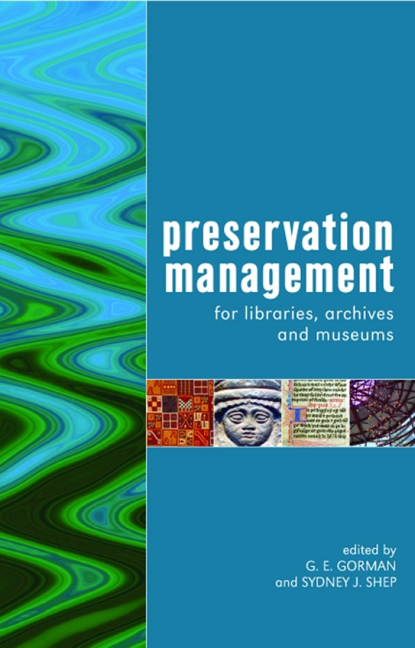Book contents
- Frontmatter
- Contents
- About the contributors
- Introduction
- 1 Managing the documentary heritage: issues for the present and future
- 2 Preservation policy and planning
- 3 Intangible heritage: museums and preservation
- 4 Surrogacy and the artefact
- 5 Moving with the times in search of permanence
- 6 Valuation model for paper conservation research: a new approach for setting research priorities
- 7 Preservation of audiovisual media: traditional to interactive formats
- 8 Challenges of managing the digitally born artefact
- 9 Preserving cultural heritage in times of conflict
- 10 Access and the social contract in memory institutions
- 11 Redefining ‘the collection’ in the 21st century
- Index
9 - Preserving cultural heritage in times of conflict
Published online by Cambridge University Press: 08 June 2018
- Frontmatter
- Contents
- About the contributors
- Introduction
- 1 Managing the documentary heritage: issues for the present and future
- 2 Preservation policy and planning
- 3 Intangible heritage: museums and preservation
- 4 Surrogacy and the artefact
- 5 Moving with the times in search of permanence
- 6 Valuation model for paper conservation research: a new approach for setting research priorities
- 7 Preservation of audiovisual media: traditional to interactive formats
- 8 Challenges of managing the digitally born artefact
- 9 Preserving cultural heritage in times of conflict
- 10 Access and the social contract in memory institutions
- 11 Redefining ‘the collection’ in the 21st century
- Index
Summary
Introduction
There are many professionals who on a daily basis struggle to safeguard all that the human mind produces, tangible as well as intangible products. Most of the time conservators try to protect our heritage against the natural process of deterioration. They fight the acidity of paper, the copper corrosion of miniatures, the chemical burning of leather, the shrinkage of overheated parchment, the disintegration of red silk or the yellowed varnish of paintings. At most, they can only stop these destructive processes temporarily as, in the end, nature will overcome all of our tangible heritage: all is lost that is delayed.
Next to the inevitable natural causes of decay, natural hazards such as earthquakes, floods, landslides, wildfires, tsunamis and tropical cyclones exact a heavy toll in terms of direct loss and irreparable damage to our cultural legacy. The consequences of the tsunami in Asia in 2004, the Katrina hurricane during the 2005 Atlantic season and the earthquake in northern Pakistan just before the severe winter of 2005/2006, were first of all horrifying because of the huge loss of human lives, but at the same time left entire regions devoid of libraries, archives and museums.
Manmade disasters can even outdo natural disasters in the detrimental effects on our collective memory of the past. Theft, war, civil disorder, terrorism, neglect and vandalism are human factors in the accidental or wilful destruction of our heritage (Teijgeler, 2001). Of these threats, armed conflict remains particularly intractable and disturbing. Regrettably, of late we have experienced more than once how shocking the effects of a violent struggle can be on the heritage of countries such as the former Yugoslavia, Afghanistan and Iraq. Statues are blown up because they are considered an insult to the ‘only and right religion’, archaeological sites are occupied by foreign troops and destroyed in the process, and archives are deliberately obliterated as part of an ethnic cleansing policy. Undoubtedly, the final decade of the 20th century was marked by destruction of heritage on a symbolic scale that has been unrivalled for the past several centuries.
- Type
- Chapter
- Information
- Preservation Management for Libraries, Archives and Museums , pp. 133 - 165Publisher: FacetPrint publication year: 2006
- 13
- Cited by



